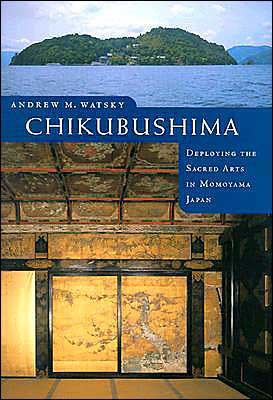Chikubushima: Deploying the Sacred Arts in Momoyama Japan available in Hardcover

Chikubushima: Deploying the Sacred Arts in Momoyama Japan
- ISBN-10:
- 0295983272
- ISBN-13:
- 9780295983271
- Pub. Date:
- 12/01/2003
- Publisher:
- University of Washington Press
- ISBN-10:
- 0295983272
- ISBN-13:
- 9780295983271
- Pub. Date:
- 12/01/2003
- Publisher:
- University of Washington Press

Chikubushima: Deploying the Sacred Arts in Momoyama Japan
Hardcover
Buy New
$65.00Buy Used
$38.89-
-
SHIP THIS ITEM
Temporarily Out of Stock Online
Please check back later for updated availability.
-
Overview

Product Details
| ISBN-13: | 9780295983271 |
|---|---|
| Publisher: | University of Washington Press |
| Publication date: | 12/01/2003 |
| Edition description: | New Edition |
| Pages: | 368 |
| Product dimensions: | 7.00(w) x 10.00(h) x (d) |
| Age Range: | 18 Years |
About the Author
Table of Contents
List of AbbreviationsNote to ReadersPreface: Considering ChikubushimaAcknowledgmentsIntroduction: The Sacred and Momoyama Japan1. Chikubushima, from Its Origins to the Ascendancy of Hideyoshi2. Hideyoshi and the Sacred: Manipulating Convention3. Encoding the Sacred4. The Material of the Sacred5. After Hideyoshi: Hideyori's Enlistment of the Sacred6. Hideyori and Chikubushima's New EnsembleEpilogue: Chikubishima in Post-Toyotomi JapanNotesAppendixBibliographyIllustration CreditsIndexWhat People are Saying About This
I used [Chikubushima] as a text for a course on Momoyama—Edo art. It is so rich, and it feeds off into so many fertile directions, that it serves as a wonderful touchstone for a plethora of important issues. These include religious praxis; the interpenetration of sacred and secular; the magical force of 'assemblage;' nuanced exposition on the profundity of place; architectural protocols; representations of the city; festivals; and tea. Students loved it. I recommend it highly for this purpose. We sorely need more books of this nature, scholarly, absorbing, and readable.
Andrew M. Watsky's eloquently written study of the island shrine of Chikubushima in Lake Biwa opens a new window on the history and culture of pre—modern Japan. What appears at first glance to be a detective story uncovering how the main hall of that shrine came to take the unusual shape it assumed early in the 17th century turns out on closer scrutiny to be an examination of the intricate relationship linking art, religion, and politics in Momoyama Japan. This is a book art historians, political historians, and scholars of religion will all learn from.
"This brilliant book..is a lavishly illustrated, luxurious book of prize-worthy beauty. The author and the designer for the Univerisy of Washington Press have turned the reading of highly complex materials into an immensely enjoyable, educational, and essentally visual pastime."—The Art Bulletin
"Andrew M. Watsky's eloquently written study of the island shrine of Chikubushima in Lake Biwa opens a new window on the history and culture of pre—modern Japan. What appears at first glance to be a detective story uncovering how the main hall of that shrine came to take the unusual shape it assumed early in the 17th century turns out on closer scrutiny to be an examination of the intricate relationship linking art, religion, and politics in Momoyama Japan. This is a book art historians, political historians, and scholars of religion will all learn from."—John Whitney Hall Book Prize Committee, 2006
"Chikubushima addresses, in refreshingly original ways, the central problems of how Momoyama art is understood and interpreted and, in so doing, raises more global issues for the discipline of art history in general. This is a superb study executed with style and verve."—Mimi Hall Yiengpruksawan, Yale University
"Chikubushima significantly enhances our understanding of a major sixteenth—century monument and of the importance its Toyotomi patrons attributed to ‘laying claim to the sacred realm.’ It offers a richly textured and evocative picture of the leading personalities, places, and cultural developments of a pivotal era in the history of modern Japan."—Christine Guth, author of The Art of Edo Japan
"I used [Chikubushima] as a text for a course on Momoyama—Edo art. It is so rich, and it feeds off into so many fertile directions, that it serves as a wonderful touchstone for a plethora of important issues. These include religious praxis; the interpenetration of sacred and secular; the magical force of 'assemblage;' nuanced exposition on the profundity of place; architectural protocols; representations of the city; festivals; and tea. Students loved it. I recommend it highly for this purpose. We sorely need more books of this nature, scholarly, absorbing, and readable."—Melinda Takeuchi, Professor of Japanese Art, Stanford University
Chikubushima addresses, in refreshingly original ways, the central problems of how Momoyama art is understood and interpreted and, in so doing, raises more global issues for the discipline of art history in general. This is a superb study executed with style and verve.
This brilliant book..is a lavishly illustrated, luxurious book of prize-worthy beauty. The author and the designer for the Univerisy of Washington Press have turned the reading of highly complex materials into an immensely enjoyable, educational, and essentally visual pastime.
Chikubushima significantly enhances our understanding of a major sixteenth—century monument and of the importance its Toyotomi patrons attributed to ‘laying claim to the sacred realm.’ It offers a richly textured and evocative picture of the leading personalities, places, and cultural developments of a pivotal era in the history of modern Japan.
